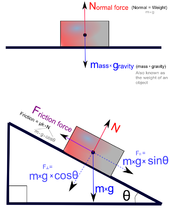Friction
force resisting the relative motion of solid surfaces, fluid layers, and material elements sliding against each other
Friction is a force that acts to stop the movement of two touching things. The energy lost to friction is turned into sound and heat. Two kinds of friction are static and kinetic. Static friction is when the friction is strong enough to stop movement between two objects. Kinetic friction is used when the frictional force is not strong enough to stop all motion. An effect of kinetic friction is heat production.
Many everyday mechanisms that use friction include car brakes, suitcases, and shoes. Even a person sliding across the floor uses a form of friction.

Some facts about friction are:
- Friction can be thought to be caused by bumps on two touching surfaces. These bumps are called asperities. As these two rough surfaces move against each other they get stuck and prevent motion until the asperities are broken or slid over. Even the smoothest materials have these asperities.

- As the force that is pushing on an object increases, the static friction increases too. However, if the force gets bigger than the maximum static friction, it makes the object accelerate. The object will begin to accelerate as soon as the static friction is less than the force pushing on it. After that point kinetic friction will act on the object.
- The coefficient of friction is the ratio between the force slowing something down and the force pushing them together. The larger it is the stronger friction is (and the more the object is slowed down). For example, a person's skates on ice have a small coefficient of friction, but rubber on concrete has a big one.
- Internal friction in a fluid is called viscosity. Viscosity is how hard it is for the fluid to move or flow. For example, honey is more "viscous" than water.
- Friction is caused by electromagnetism. When the atoms that make the objects come close they are drawn to each other and may connect. Effort is needed to break this connection in objects that are not moving and effort is needed to keep an object moving against this attraction. Things with high friction have many points of contact or have atoms that strongly attract others. There are 4 types of friction. Static, sliding, rolling,Fluid friction.